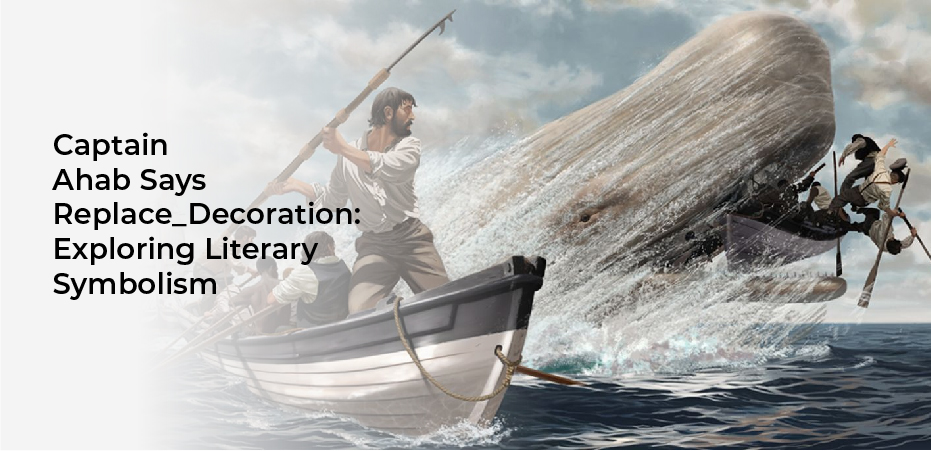Are you a fan of Moby-Dick? Have you ever wondered about the symbolism behind Captain Ahab’s character? If so, you’re in luck. In this article, we’ll be exploring the literary symbolism of Captain Ahab and his famous phrase, ‘Replace_Decoration.’
Captain Ahab is one of the most iconic characters in American literature. He’s the captain of the Pequod, a whaling ship on a mission to capture the elusive white whale, Moby-Dick. Ahab is known for his obsession with the whale, which ultimately leads to his downfall. But there’s more to Ahab than just his obsession. His character is full of symbolism, from his peg leg to his monomaniacal pursuit of Moby-Dick.
And then there’s his famous phrase, ‘Replace_Decoration.’ What does it mean, and how does it contribute to the overall symbolism of the novel? Let’s find out.
Introduction to Captain Ahab
Meet Captain Ahab, the enigmatic protagonist of Herman Melville’s classic novel Moby-Dick. You may have heard of him before, or perhaps you’re just getting to know him now.
Either way, Captain Ahab is a character that sticks with you long after you’ve finished reading the book.
Ahab is the captain of the whaling ship Pequod and is on a mission to hunt down and kill the infamous white whale, Moby Dick.
However, Ahab is not just a simple whaler seeking a prize. He’s a complex character driven by a deep obsession and a desire for revenge.
His leg was bitten off by Moby Dick on a previous voyage, and now he’s consumed by the need to destroy the whale that took his limb.
Ahab’s journey is one of self-destruction as he becomes more and more consumed by his obsession, ultimately leading to the tragic downfall of himself and his crew.
The Significance of “Replace_Decoration”
As we delve deeper into the meaning behind ‘replace_decoration,’ we can visualize the layers of symbolism it adds to the narrative. This phrase appears in Herman Melville’s novel, Moby-Dick, in a passage where Captain Ahab insists on replacing the whale’s tooth that he wears around his neck with a golden chain.
On the surface, this seems like a simple act of vanity or materialism. However, when we examine the context and language used, we can see that the act of replacing the decoration holds much deeper significance.
The word ‘replace’ suggests a sense of substitution, of exchanging something old for something new. This can be seen as a metaphor for Ahab’s obsession with hunting the white whale, as he’s willing to trade everything he has for the chance to finally capture it.
The word ‘decoration’ implies that the whale’s tooth is merely a superficial adornment, but it holds a deeper meaning for Ahab as a symbol of his power and authority as captain. By replacing it with a golden chain, he’s attempting to assert his dominance over the whale and his crew, but ultimately, this act represents his downfall.
Symbolism in Captain Ahab’s Character
Through his actions and words, it becomes clear that Captain Ahab, the protagonist of Moby-Dick, is a complex and multi-dimensional character with layers of meaning that extend far beyond his surface-level motivations.
Ahab’s obsession with the white whale is often seen as a symbol of humanity’s struggle against the uncontrollable forces of nature. His relentless pursuit of Moby Dick represents the human desire to conquer and control the natural world. However, Ahab’s monomaniacal focus on the whale also represents the dangers of obsession and the destructive power of unchecked ambition.
Ahab’s character is also rich in religious symbolism. His name, for example, is a reference to the wicked king in the biblical story of Jezebel. Ahab’s quest for revenge against the white whale can be seen as a metaphor for the human quest for revenge against God for the evils of the world. Ahab’s obsession with Moby Dick can also be interpreted as a rejection of God’s plan for the world and a desire to take matters into his own hands.
Overall, Ahab’s character is a prime example of the power of symbolism in literature, and how it can add depth and complexity to a story.
Ahab’s Motivation and Obsession
Ahab’s unrelenting pursuit of Moby Dick highlights the dangerous consequences of unchecked ambition and the destructive power of obsession. His motivation to hunt the white whale stems from a need for revenge, as Moby Dick had taken his leg in a previous encounter.
However, as the journey progresses, it becomes clear that Ahab’s obsession goes beyond mere revenge. He becomes consumed by the idea of killing the whale, to the point where he is willing to sacrifice the lives of his crew and his own well-being.
Ahab’s obsession is portrayed as a force that drives him to madness, and is ultimately his downfall. He becomes so consumed by the hunt that he loses sight of everything else, including his own safety and the well-being of his crew.
His single-minded focus on Moby Dick leads him to pursue the whale even when it is clear that it is a danger to his ship and crew. Ahab’s story serves as a cautionary tale about the dangers of obsession, and the importance of keeping one’s ambitions in check.
Analyzing the Impact of “Replace_Decoration” on the Narrative
You can appreciate the impact of ‘Replace_Decoration’ on the narrative by closely examining the subtle changes in the tone and mood of the story. This literary device is used to replace a common object or symbol with another, which can create a different meaning or emphasize a particular theme.
In the case of ‘Moby-Dick,’ the use of ‘Replace_Decoration’ is evident in the numerous references to the color white, which is both a symbol of purity and a representation of death. The color white is associated with Moby Dick, the elusive white whale, and is used to emphasize the destructive nature of Ahab’s obsession.
Throughout the novel, Melville uses ‘Replace_Decoration’ to create a sense of foreboding and unease. The constant references to the color white and the symbolism it represents creates a pervasive sense of dread that permeates the narrative. This use of literary symbolism also serves to underscore the theme of human obsession and the destructive nature of unchecked ambition.
By replacing the traditional symbolic associations with a new meaning, Melville is able to create a unique and powerful narrative that speaks to the human condition.
Frequently Asked Questions
Who is the author of the article?
You’re asking who wrote the article. The author’s name isn’t provided, so it’s unclear. Perhaps more information can be found by doing a search or checking the source of the article.
What is the historical context in which Moby Dick was written?
Moby Dick was written by Herman Melville in the mid-19th century. The historical context was the rise of industrialization, the decline of whaling, and the tension between science and religion.
How has the interpretation of Captain Ahab’s character changed over time?
You’ll find that the interpretation of Captain Ahab’s character has varied over time. Some see him as a tragic hero, others as a symbol of obsession and madness. It all depends on the reader’s perspective.
What is the significance of the whale in Moby Dick beyond its role as a plot device?
You may not realize the whale in Moby Dick symbolizes more than just a plot device. Its significance lies in its representation of nature’s power, man’s hubris, and the eternal struggle between good and evil.
How does the use of symbolism in Moby Dick compare to other works of literature from the same time period?
You’ll find that Moby Dick’s use of symbolism was revolutionary for its time, with Melville exploring deeper themes beyond just plot. It stands out among other works from the same period for this reason.
Conclusion
Congratulations! You’ve now explored the literary symbolism of Captain Ahab and his infamous phrase ‘replace_decoration’. Through this analysis, you’ve gained a deeper understanding of Ahab’s character, motivation, and obsession. You’ve also seen how the symbolic meaning of ‘replace_decoration’ impacts the narrative of Moby-Dick.
By examining Ahab’s character and his actions, you can see how the phrase ‘replace_decoration’ represents his desire for revenge and his relentless pursuit of the white whale. This symbolism adds a layer of complexity to the story and highlights the destructive nature of obsession.
In conclusion, the use of symbolism in literature can enrich our understanding of characters and themes. Through exploring Ahab’s character and his use of ‘replace_decoration’, we can see the power of symbolism in shaping a narrative.
Keep exploring and analyzing literary symbolism to gain a deeper appreciation for the art of storytelling.


